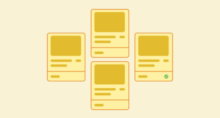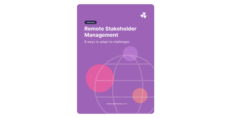Ladder of Participation: Quick-Start Guide to Applying This Framework

Do you want to increase meaningful participation from your stakeholders or citizens — even to the point of collaborating with them?
It’s a good goal to have! After all, participation is essential for gaining more insights, making better informed decisions, and maintaining a democratic process that builds trust in your institution and its decisions.
One really useful tool for understanding participation is the Ladder of Participation. This model can be used by leaders in government and those working in community engagement and public consultation to understand and plan their engagement with participation in mind.
In this guide, we dive into this framework, how you can use it, and some limitations to be aware of.
What is the Ladder of Participation?

The Ladder of Participation is a framework or model that can be used to classify a stakeholder, community, or citizen engagement project based on the degree of participation or power given to stakeholders.
It can be useful for understanding how public participation and citizen engagement work, and how power can be distributed between participants. It can help with identifying who holds power, and work strategically to more fairly and equitably distribute this power.
The model was created by Sherry Arnstein and originally appeared in the Journal of the American Planning Association in 1969, and it continues to have an impact today. To sum up the model:
- Lower rungs are essentially non-participatory. They might involve the kind of engagement that seeks to educate stakeholders or push them towards a certain goal or viewpoint.
- Middle rungs on the ladder could be labelled as tokenistic — the kind of engagement or participation that looks good from the outside, but doesn’t accomplish anything meaningful.
- Higher rungs involve greater levels of participation, and greater degrees of power or influence given to your citizen stakeholders.
The idea of Anstein’s Ladder of Participation is that the higher you climb, the more you achieve an ideal level of engagement or participation. Though, this ideal level will also depend on your specific engagement goals and situation — it won’t always be possible to hand over control of decisions to citizens.
What About the Ladder of Engagement?

Before we go any further, it’s important to note that there is also a Ladder of Engagement. Just to make things nice and confusing! You might have heard of this model, especially if you work in nonprofit stakeholder engagement or grassroots advocacy.
The Ladder of Engagement framework is used to indicate different levels of commitment or relationships with an audience, from Observing through to Leading. The theory is that an audience or stakeholder starts at the bottom and progresses through each stage, leading to more support for your organization. In a non-profit organization, greater levels of commitment could result in donating funds, volunteering time, and even becoming a member.
While the Ladder of Engagement measures or tracks levels, it doesn’t quite look the same as Arnstein’s Ladder of Participation. And it isn’t used in the same way.
The Ladder of Engagement might be used to strategically map small steps to get your audience to increase their level of support for or commitment towards your non-profit or cause. But the Ladder of Participation is best used to set participation goals and evaluate the degree to which your citizen engagement or public participation campaign is sharing power with community members.
Now, back to the Ladder of Participation…
Breaking Down the Ladder of Participation
Let’s break down each rung of the ladder, starting from the bottom:
- Manipulation – Citizens are led to believe they have power and are participating, but the process is designed for nothing more than checking the boxes and keeping up the appearance of participation.
- Therapy – Stakeholders are encouraged to participate in programs that make them see themselves as the problem that needs fixing (rather than the policies or institutions behind them).
- Informing – Citizens receive a one-way flow of information (which may be designed to confuse/overwhelm/intimidate) without opportunities to provide feedback.
- Consultation – Involves some degree of participation through options like surveys, meetings, and enquiries that invite the opinions of citizens, though their input may or may not be used to influence decisions.
- Placation – Some citizens may be granted limited influence (e.g. handpicking individuals for an advisory/planning committee), but this is mainly tokenistic, with others retaining the ability to make decisions and ignore/accept stakeholders’ advice.
- Partnership – Citizens and officials or institutions each have the capacity to make decisions through structured partnerships (like boards and committees).
- Delegation – Citizens have the power to make decisions about a program, likely because as majority board members, they hold the majority votes.
- Citizen Control – Citizens are entirely in control of an institution, policy, or program, including planning, decision-making, and management (such as a local neighborhood watch program).
4 Steps to Applying The Ladder of Participation

To use the Ladder of Participation in your citizen engagement or public participation project, follow these four key steps:
1. Set Your Goals
Start by determining what you want to get out of this framework. Do you want to…
- Evaluate the level of participation within your consultation?
- Assign a desired level of participation (in your consultation plan) based on your program requirements or ideologies? Or a desired level of participation for specific stakeholders or groups?
- Monitor your participation levels over time, and across different programs?
- Analyze the impact of participation levels on your project outcomes, stakeholder satisfaction, or something else?
Note down your goal as part of your consultation plan or evaluation plan, including (if relevant) the specific level of participation you’re aiming for.
2. Replicate Framework
It’s worth using a simplified version of the Ladder of Participation that you can easily refer to and/or mark up as part of your planning, evaluation, or analysis. To make this easy, feel free to copy the below table into your own document:
| Citizen Control | Citizens are fully in control of an institution, policy, or program. | ← Citizen Power |
| Delegated Power | Citizens have the majority and hold more control over a program than officials/institutions. | |
| Partnership | Structured partnerships where both citizens and officials can make decisions together. | |
| Placation | Hand-picked individuals with limited influence whose input may be ignored by decision-makers. | ← Tokenism |
| Consultation | Limited participation that may or may not be used to influence decisions. | |
| Informing | One-way flow of information with no feedback opportunities. | |
| Therapy | Citizens (rather than policy, program, or institution) are positioned as the problem. | ← Non-Participation |
| Manipulation | Box-checking with the illusion of participation. |
3. Measure Participation
To use the Ladder of Participation, you’ll need to examine your consultation process carefully and to understand which level you fall within. Here are some useful questions to ask yourself:
- Is the consultation mainly designed to keep up the appearance of participation or democracy?
- Is your goal to influence the perception of your citizens so that you don’t need to change your plans, policies, or programs?
- Is participation open to everyone, or just specific groups or individuals?
- How transparent and detailed is the information you share with stakeholders?
- When you share information with stakeholders, do you provide opportunities for feedback? And are stakeholders taking advantage of opportunities to provide feedback?
- Are you required to consider stakeholder feedback when making decisions?
- Are decisions made on behalf of citizens, or in collaboration with them?
- Are most of the participating decision makers citizens, officials, or members of the institution?
4. Apply Your Learnings
This final step will depend on the goals you set, and whether you’re using the ladder for analysis, evaluation, planning, or something else.
You may find that your consultation plans or activities require some changes in order to meet your desired level of participation. For instance, you may need to:
- Share more information with stakeholders to keep them informed
- Incorporate more feedback mechanisms (like surveys, meetings, or focus groups)
- Create collaborative structures like boards or committees
- Bring more citizens into your decision-making panel
- Improve how you track and report on stakeholder input — and how it’s used to make decisions
By applying your learnings from the Ladder of Participation, you’ll likely find yourself following more stakeholder engagement best practices that help you achieve better, fairer outcomes — and that build trust and accountability for your organization.
If You Must Use the Ladder of Participation, Do This

It’s important to note that the Ladder of Participation is only one of many models and frameworks. It shouldn’t be relied upon as a standalone framework to guide your consultation because it does have a number of limitations. For instance:
- The issue of power – As we’ve mentioned in other articles previously, stakeholder power has changed substantially since models like this one were created. These days, nearly any stakeholder can wield power and influence your consultation through something as simple and accessible as a social media post.
- Lack of other dimensions – Again, this model primarily focuses on the dimension of power. But there are many other dimensions worth considering, such as….
- Over-simplified hierarchy – The assumption with the Ladder of Participation is that higher is better. But higher isn’t necessarily better for all situations, policies, or programs. Some decisions may require specialized skills or confidential knowledge that ordinary citizens don’t have access to. Sometimes there won’t be time or budget to work through a full, participatory process.
Despite these limitations, the ladder may still be worth bringing into your consultation planning and evaluation — even if it’s just to build a shared understanding around the type of consultation you’re expected to run. And it can help to facilitate discussions around the importance of engaging in more meaningful ways, rather than engaging with stakeholders to make your organization look good.
So, if you do choose to use this framework, consider including some other methods of planning, tracking, and evaluating your engagement. This could include stakeholder mapping, stakeholder relationship networking, and the evaluation framework we outlined in this eBook.
Learn More
Interested in discovering more content like this, including other stakeholder models, frameworks, and diagrams? Check out our previous posts, including:
- 6 Stakeholder Mapping Templates [Downloadable + Editable]
- Stakeholder Engagement Assessment Matrix: Problems and Alternatives
- Using a Stakeholder Matrix: 3 Practical Examples
- How to Conduct a Stakeholder Assessment
- 15 Stakeholder Diagrams To Add To Your Toolkit
- Engaging Communities: 7 Tips to Boost Participation
- 7 truths about accountability in public participation that you need to know
- Strategies for Successful Community Engagement in Government






























